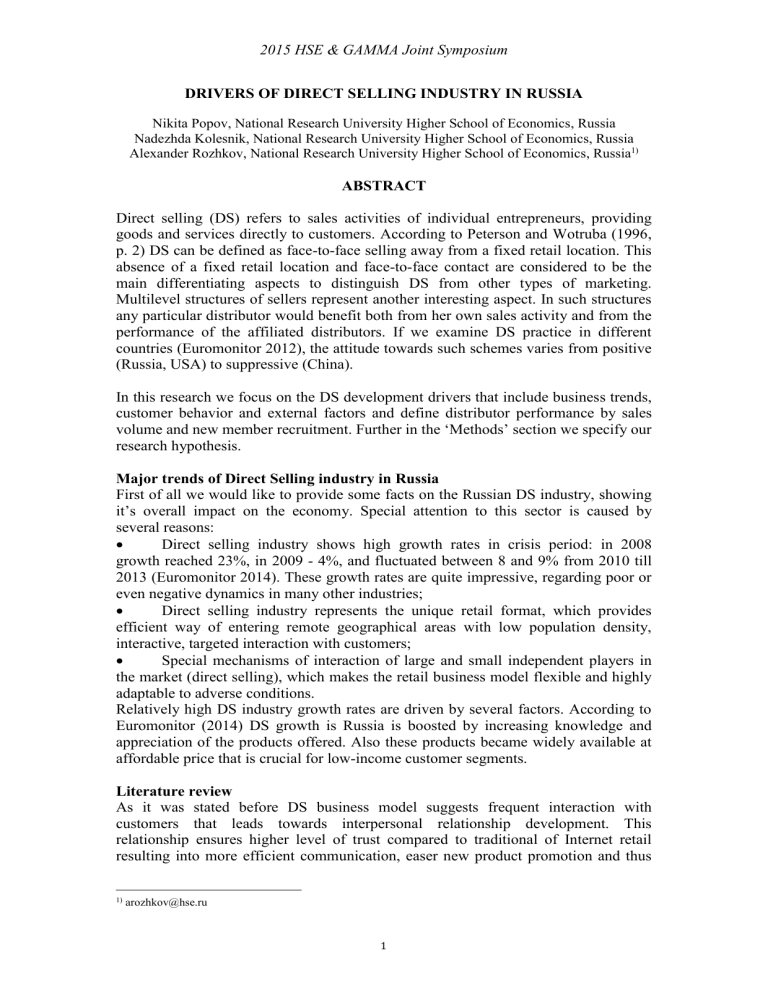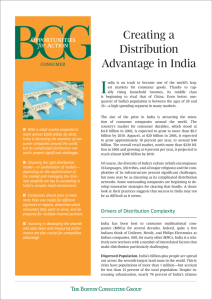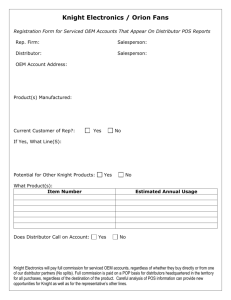2015 HSE & GAMMA Joint Symposium DRIVERS OF DIRECT

2015 HSE & GAMMA Joint Symposium
DRIVERS OF DIRECT SELLING INDUSTRY IN RUSSIA
Nikita Popov, National Research University Higher School of Economics, Russia
Nadezhda Kolesnik, National Research University Higher School of Economics, Russia
Alexander Rozhkov, National Research University Higher School of Economics, Russia 1)
ABSTRACT
Direct selling (DS) refers to sales activities of individual entrepreneurs, providing goods and services directly to customers. According to Peterson and Wotruba (1996, p. 2) DS can be defined as face-to-face selling away from a fixed retail location. This absence of a fixed retail location and face-to-face contact are considered to be the main differentiating aspects to distinguish DS from other types of marketing.
Multilevel structures of sellers represent another interesting aspect. In such structures any particular distributor would benefit both from her own sales activity and from the performance of the affiliated distributors. If we examine DS practice in different countries (Euromonitor 2012), the attitude towards such schemes varies from positive
(Russia, USA) to suppressive (China).
In this research we focus on the DS development drivers that include business trends, customer behavior and external factors and define distributor performance by sales volume and new member recruitment. Further in the ‘Methods’ section we specify our research hypothesis.
Major trends of Direct Selling industry in Russia
First of all we would like to provide some facts on the Russian DS industry, showing it’s overall impact on the economy. Special attention to this sector is caused by several reasons:
Direct selling industry shows high growth rates in crisis period: in 2008 growth reached 23%, in 2009 - 4%, and fluctuated between 8 and 9% from 2010 till
2013 (Euromonitor 2014). These growth rates are quite impressive, regarding poor or even negative dynamics in many other industries;
Direct selling industry represents the unique retail format, which provides efficient way of entering remote geographical areas with low population density, interactive, targeted interaction with customers;
Special mechanisms of interaction of large and small independent players in the market (direct selling), which makes the retail business model flexible and highly adaptable to adverse conditions.
Relatively high DS industry growth rates are driven by several factors. According to
Euromonitor (2014) DS growth is Russia is boosted by increasing knowledge and appreciation of the products offered. Also these products became widely available at affordable price that is crucial for low-income customer segments.
Literature review
As it was stated before DS business model suggests frequent interaction with customers that leads towards interpersonal relationship development. This relationship ensures higher level of trust compared to traditional of Internet retail resulting into more efficient communication, easer new product promotion and thus
1) arozhkov@hse.ru
1
2015 HSE & GAMMA Joint Symposium superior sales performance. According to Luk, Fullgrabe, and Yi (1996) findings establishing relationship is more important than the product itself in high-context
Chinese culture. Moreover about 50% of customers are recruited from friends and family of the distributor. Similar sales structure is observed in Taiwan (Chen, Jeng,
Chou, 1998). Comparative study of DS in Australia and China observes roles of product based elements and relationships in DS. Research shows that both product elements and relationship elements are perceived by salespeople as being important to the customer, for effective direct selling in both countries, though relatively, relationship elements seemed to be somewhat more important in Asia. Study has identified the importance of friendship, trust, reciprocity, and overall personal relationship as important drivers to distributor performance (Merrilees, Miller, 1999).
International study concerning DS public perspective was held by researchers from
Australia, Finland, New Zealand, South Africa, Taiwan, UK, USA. They argue that currently majority of people has a positive perception of direct selling. About 90% of previous customers would use this channel of distribution again. Globally communication channel based on existing relationships is most popular. About 58% of all respondents have bought from family and friends, rather than a stranger (Brodie,
Albaum, Chen, Garcia, et al., 2004).
Research question
As we discussed above DS business model performance is based on a complex combination of market-level factors and personal-level factors including product perception and emerging customer-distributor relations. In this paper we explore the impact of both market- and personal-level factors on the distributor performance. We assume that distributor performance is influenced by the structure of communication channel (1), distributor motivation (2), education level (3), level of professional skills and self-development (4) that define relationship-building capability.
Data collection and methods
The research project and data collection were carried out by the request and with the assistance of the Russian Direct Selling Association (RDSA) in two subsequent research projects: from January to July 2011 and from February to June 2014.
We used exiting DSA survey toolkit as the basis for the questionnaire development.
This toolkit was updated according the research focus. There were also some minor changes in the questionnaire on the draft stage. We modified a number of statements in order to facilitate understanding and exclude misinterpretation.
Sample
The questionnaires were sent to 16 companies with RDSA membership, the sample was quoted according to the number of the distributors. The total number of the questionnaires filled in reached 6380 and 5638 in 2011 and 2014 respectively, representing 74 Russian regions. Questionnaires were collected and encoded into a database.
Measures
The questionnaire consisted of 39 questions in four main sections: demographic data
(gender, age, presence of children, the number of family members, region of residence, etc.), activities in the field of direct selling (use of the product for personal purposes, years of experience in the industry, the time spent per week, motivation, level of earnings, the main ways to promote products and customer service), the
2
2015 HSE & GAMMA Joint Symposium impact of direct selling (the benefits for the customer, the main problems and obstacles to development) and the recruitment of new employees (the number of involved distributors, the main problem).
Results
As the result of the study we provide comparative analysis for of DS industry between
2011 and 2014. Moreover we explore existing DS trends and impact of market-level and personal factors on the distributor performance.
Keywords: Direct Selling Industry, Russia, Retail location, DS development drivers,
Marketing.
References
Brodie S. et al(2004). Public perceptions of direct selling: An international perspective , Westminster Business School Research Report , 2004, С. 18-2004.
Chen D. F. R., Jeng L. J., Chou C. C.(1998). A study of consumers who buy from
MLM channel in Taiwan, 1998 Asia Pacific Decision Sciences Institute
Conference Proceeding, 1998, С. 205-211.
Luk S. T. K., Fullgrabe L., Li S. C. Y.(1999). Managing direct selling activities in
China: A cultural explanation. Journal of Business Research , 1999, Vol. 45-3, page 257-266.
Merrilees B., Miller D.(1999). Direct selling in the west and east: The relative roles of product and relationship (guanxi) drivers, Journal of Business Research , 1999
Vol. 45–3, page 267-273.
Peterson, R. A., Wotruba, T. R.(1996). What is direct selling? – Definition, perspectives, and research agenda, The Journal of Personal Selling and Sales
Management , 1996, Vol. 16–4, page 1-16.
Wotruba T. R., Pribova M. Direct Selling in an emerging market economy: a comparison of Czech/Slovak and US market characteristics and buying experiences, International Review of Retail, Distribution and Consumer Research .,
1996, Vol. 6–4, page 415-435.
3






